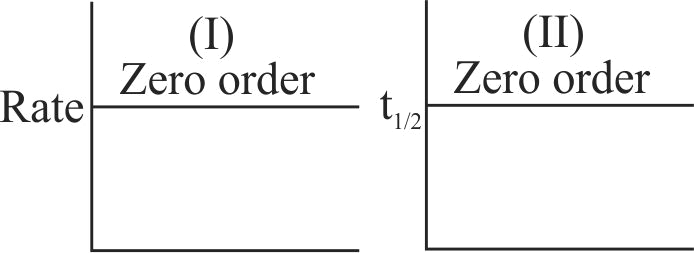320493
Diazonium salt decomposes as \(\mathrm{C}_{6} \mathrm{H}_{5} \mathrm{~N}_{2}^{+} \mathrm{Cl}^{-} \rightarrow \mathrm{C}_{6} \mathrm{H}_{5} \mathrm{Cl}+\mathrm{N}_{2}\)
At \(0^{\circ} \mathrm{C}\), the evolution of \({{\rm{N}}_{\rm{2}}}\) becomes two times faster when the initial concentration of the salt is doubled. Therefore, it is
320495 For reaction, \(\mathrm{aA} \rightarrow \mathrm{xp}\), when \([\mathrm{A}]=2.2 \mathrm{mM}\) the rate was found to be \(2.4 \mathrm{mMs}^{-1}\). On reducing concentration of \(\mathrm{A}\) to half, the rate changes to \(0.6 \mathrm{mMs}^{-1}\). The order of reaction with respect to \(\mathrm{A}\) is
320497
The bromination of acetone that occurs in acid solution is represented by this equation.
\(\begin{aligned}& \mathrm{CH}_{3} \mathrm{COCH}_{3}(a q)+\mathrm{Br}_{2}(a q) \rightarrow \\& \mathrm{CH}_{3} \mathrm{COCH}_{2} \mathrm{Br}(a q)+\mathrm{H}^{+}(a q)+\mathrm{Br}^{-}(a q)\end{aligned}\)
These kinetic data were obtained for given eaction concentrations.
Initial concentrations, \(\mathrm{M}\)
\[\begin{array}{*{20}{c}}{\left[ {{\rm{C}}{{\rm{H}}_{\rm{3}}}{\rm{COC}}{{\rm{H}}_{\rm{3}}}} \right]}&{{\rm{B}}{{\rm{r}}_{\rm{2}}}}&{{{\rm{H}}^{{\rm{ + }}}}}&{{\rm{Initial}}{\mkern 1mu} {\mkern 1mu} {\rm{rate, }}}\\
{\rm{ }}&{}&{}&{{\rm{disappearance}}{\mkern 1mu} {\mkern 1mu} {\rm{of}}{\mkern 1mu} {\mkern 1mu} {\rm{B}}{{\rm{r}}_{\rm{2}}}}\\{{\rm{0}}{\rm{.30}}}&{{\rm{0}}{\rm{.05}}}&{{\rm{0}}{\rm{.05}}}&{{\rm{5}}{\rm{.7 \times 1}}{{\rm{0}}^{{\rm{ - 5}}}}}\\{{\rm{0}}{\rm{.30}}}&{{\rm{0}}{\rm{.10}}}&{{\rm{0}}{\rm{.05}}}&{{\rm{5}}{\rm{.7 \times 1}}{{\rm{0}}^{{\rm{ - 5}}}}}\\{{\rm{0}}{\rm{.30}}}&{{\rm{0}}{\rm{.10}}}&{{\rm{0}}{\rm{.10}}}&{{\rm{1}}{\rm{.2 \times 1}}{{\rm{0}}^{{\rm{ - 4}}}}}\\{{\rm{0}}{\rm{.40}}}&{{\rm{0}}{\rm{.05}}}&{{\rm{0}}{\rm{.20}}}&{{\rm{3}}{\rm{.1 \times 1}}{{\rm{0}}^{{\rm{ - 4}}}}}\\{}&{}&{}&{}\end{array}\]
Based on these data, the rate equation is
320493
Diazonium salt decomposes as \(\mathrm{C}_{6} \mathrm{H}_{5} \mathrm{~N}_{2}^{+} \mathrm{Cl}^{-} \rightarrow \mathrm{C}_{6} \mathrm{H}_{5} \mathrm{Cl}+\mathrm{N}_{2}\)
At \(0^{\circ} \mathrm{C}\), the evolution of \({{\rm{N}}_{\rm{2}}}\) becomes two times faster when the initial concentration of the salt is doubled. Therefore, it is
320495 For reaction, \(\mathrm{aA} \rightarrow \mathrm{xp}\), when \([\mathrm{A}]=2.2 \mathrm{mM}\) the rate was found to be \(2.4 \mathrm{mMs}^{-1}\). On reducing concentration of \(\mathrm{A}\) to half, the rate changes to \(0.6 \mathrm{mMs}^{-1}\). The order of reaction with respect to \(\mathrm{A}\) is
320497
The bromination of acetone that occurs in acid solution is represented by this equation.
\(\begin{aligned}& \mathrm{CH}_{3} \mathrm{COCH}_{3}(a q)+\mathrm{Br}_{2}(a q) \rightarrow \\& \mathrm{CH}_{3} \mathrm{COCH}_{2} \mathrm{Br}(a q)+\mathrm{H}^{+}(a q)+\mathrm{Br}^{-}(a q)\end{aligned}\)
These kinetic data were obtained for given eaction concentrations.
Initial concentrations, \(\mathrm{M}\)
\[\begin{array}{*{20}{c}}{\left[ {{\rm{C}}{{\rm{H}}_{\rm{3}}}{\rm{COC}}{{\rm{H}}_{\rm{3}}}} \right]}&{{\rm{B}}{{\rm{r}}_{\rm{2}}}}&{{{\rm{H}}^{{\rm{ + }}}}}&{{\rm{Initial}}{\mkern 1mu} {\mkern 1mu} {\rm{rate, }}}\\
{\rm{ }}&{}&{}&{{\rm{disappearance}}{\mkern 1mu} {\mkern 1mu} {\rm{of}}{\mkern 1mu} {\mkern 1mu} {\rm{B}}{{\rm{r}}_{\rm{2}}}}\\{{\rm{0}}{\rm{.30}}}&{{\rm{0}}{\rm{.05}}}&{{\rm{0}}{\rm{.05}}}&{{\rm{5}}{\rm{.7 \times 1}}{{\rm{0}}^{{\rm{ - 5}}}}}\\{{\rm{0}}{\rm{.30}}}&{{\rm{0}}{\rm{.10}}}&{{\rm{0}}{\rm{.05}}}&{{\rm{5}}{\rm{.7 \times 1}}{{\rm{0}}^{{\rm{ - 5}}}}}\\{{\rm{0}}{\rm{.30}}}&{{\rm{0}}{\rm{.10}}}&{{\rm{0}}{\rm{.10}}}&{{\rm{1}}{\rm{.2 \times 1}}{{\rm{0}}^{{\rm{ - 4}}}}}\\{{\rm{0}}{\rm{.40}}}&{{\rm{0}}{\rm{.05}}}&{{\rm{0}}{\rm{.20}}}&{{\rm{3}}{\rm{.1 \times 1}}{{\rm{0}}^{{\rm{ - 4}}}}}\\{}&{}&{}&{}\end{array}\]
Based on these data, the rate equation is
320493
Diazonium salt decomposes as \(\mathrm{C}_{6} \mathrm{H}_{5} \mathrm{~N}_{2}^{+} \mathrm{Cl}^{-} \rightarrow \mathrm{C}_{6} \mathrm{H}_{5} \mathrm{Cl}+\mathrm{N}_{2}\)
At \(0^{\circ} \mathrm{C}\), the evolution of \({{\rm{N}}_{\rm{2}}}\) becomes two times faster when the initial concentration of the salt is doubled. Therefore, it is
320495 For reaction, \(\mathrm{aA} \rightarrow \mathrm{xp}\), when \([\mathrm{A}]=2.2 \mathrm{mM}\) the rate was found to be \(2.4 \mathrm{mMs}^{-1}\). On reducing concentration of \(\mathrm{A}\) to half, the rate changes to \(0.6 \mathrm{mMs}^{-1}\). The order of reaction with respect to \(\mathrm{A}\) is
320497
The bromination of acetone that occurs in acid solution is represented by this equation.
\(\begin{aligned}& \mathrm{CH}_{3} \mathrm{COCH}_{3}(a q)+\mathrm{Br}_{2}(a q) \rightarrow \\& \mathrm{CH}_{3} \mathrm{COCH}_{2} \mathrm{Br}(a q)+\mathrm{H}^{+}(a q)+\mathrm{Br}^{-}(a q)\end{aligned}\)
These kinetic data were obtained for given eaction concentrations.
Initial concentrations, \(\mathrm{M}\)
\[\begin{array}{*{20}{c}}{\left[ {{\rm{C}}{{\rm{H}}_{\rm{3}}}{\rm{COC}}{{\rm{H}}_{\rm{3}}}} \right]}&{{\rm{B}}{{\rm{r}}_{\rm{2}}}}&{{{\rm{H}}^{{\rm{ + }}}}}&{{\rm{Initial}}{\mkern 1mu} {\mkern 1mu} {\rm{rate, }}}\\
{\rm{ }}&{}&{}&{{\rm{disappearance}}{\mkern 1mu} {\mkern 1mu} {\rm{of}}{\mkern 1mu} {\mkern 1mu} {\rm{B}}{{\rm{r}}_{\rm{2}}}}\\{{\rm{0}}{\rm{.30}}}&{{\rm{0}}{\rm{.05}}}&{{\rm{0}}{\rm{.05}}}&{{\rm{5}}{\rm{.7 \times 1}}{{\rm{0}}^{{\rm{ - 5}}}}}\\{{\rm{0}}{\rm{.30}}}&{{\rm{0}}{\rm{.10}}}&{{\rm{0}}{\rm{.05}}}&{{\rm{5}}{\rm{.7 \times 1}}{{\rm{0}}^{{\rm{ - 5}}}}}\\{{\rm{0}}{\rm{.30}}}&{{\rm{0}}{\rm{.10}}}&{{\rm{0}}{\rm{.10}}}&{{\rm{1}}{\rm{.2 \times 1}}{{\rm{0}}^{{\rm{ - 4}}}}}\\{{\rm{0}}{\rm{.40}}}&{{\rm{0}}{\rm{.05}}}&{{\rm{0}}{\rm{.20}}}&{{\rm{3}}{\rm{.1 \times 1}}{{\rm{0}}^{{\rm{ - 4}}}}}\\{}&{}&{}&{}\end{array}\]
Based on these data, the rate equation is
320493
Diazonium salt decomposes as \(\mathrm{C}_{6} \mathrm{H}_{5} \mathrm{~N}_{2}^{+} \mathrm{Cl}^{-} \rightarrow \mathrm{C}_{6} \mathrm{H}_{5} \mathrm{Cl}+\mathrm{N}_{2}\)
At \(0^{\circ} \mathrm{C}\), the evolution of \({{\rm{N}}_{\rm{2}}}\) becomes two times faster when the initial concentration of the salt is doubled. Therefore, it is
320495 For reaction, \(\mathrm{aA} \rightarrow \mathrm{xp}\), when \([\mathrm{A}]=2.2 \mathrm{mM}\) the rate was found to be \(2.4 \mathrm{mMs}^{-1}\). On reducing concentration of \(\mathrm{A}\) to half, the rate changes to \(0.6 \mathrm{mMs}^{-1}\). The order of reaction with respect to \(\mathrm{A}\) is
320497
The bromination of acetone that occurs in acid solution is represented by this equation.
\(\begin{aligned}& \mathrm{CH}_{3} \mathrm{COCH}_{3}(a q)+\mathrm{Br}_{2}(a q) \rightarrow \\& \mathrm{CH}_{3} \mathrm{COCH}_{2} \mathrm{Br}(a q)+\mathrm{H}^{+}(a q)+\mathrm{Br}^{-}(a q)\end{aligned}\)
These kinetic data were obtained for given eaction concentrations.
Initial concentrations, \(\mathrm{M}\)
\[\begin{array}{*{20}{c}}{\left[ {{\rm{C}}{{\rm{H}}_{\rm{3}}}{\rm{COC}}{{\rm{H}}_{\rm{3}}}} \right]}&{{\rm{B}}{{\rm{r}}_{\rm{2}}}}&{{{\rm{H}}^{{\rm{ + }}}}}&{{\rm{Initial}}{\mkern 1mu} {\mkern 1mu} {\rm{rate, }}}\\
{\rm{ }}&{}&{}&{{\rm{disappearance}}{\mkern 1mu} {\mkern 1mu} {\rm{of}}{\mkern 1mu} {\mkern 1mu} {\rm{B}}{{\rm{r}}_{\rm{2}}}}\\{{\rm{0}}{\rm{.30}}}&{{\rm{0}}{\rm{.05}}}&{{\rm{0}}{\rm{.05}}}&{{\rm{5}}{\rm{.7 \times 1}}{{\rm{0}}^{{\rm{ - 5}}}}}\\{{\rm{0}}{\rm{.30}}}&{{\rm{0}}{\rm{.10}}}&{{\rm{0}}{\rm{.05}}}&{{\rm{5}}{\rm{.7 \times 1}}{{\rm{0}}^{{\rm{ - 5}}}}}\\{{\rm{0}}{\rm{.30}}}&{{\rm{0}}{\rm{.10}}}&{{\rm{0}}{\rm{.10}}}&{{\rm{1}}{\rm{.2 \times 1}}{{\rm{0}}^{{\rm{ - 4}}}}}\\{{\rm{0}}{\rm{.40}}}&{{\rm{0}}{\rm{.05}}}&{{\rm{0}}{\rm{.20}}}&{{\rm{3}}{\rm{.1 \times 1}}{{\rm{0}}^{{\rm{ - 4}}}}}\\{}&{}&{}&{}\end{array}\]
Based on these data, the rate equation is
320493
Diazonium salt decomposes as \(\mathrm{C}_{6} \mathrm{H}_{5} \mathrm{~N}_{2}^{+} \mathrm{Cl}^{-} \rightarrow \mathrm{C}_{6} \mathrm{H}_{5} \mathrm{Cl}+\mathrm{N}_{2}\)
At \(0^{\circ} \mathrm{C}\), the evolution of \({{\rm{N}}_{\rm{2}}}\) becomes two times faster when the initial concentration of the salt is doubled. Therefore, it is
320495 For reaction, \(\mathrm{aA} \rightarrow \mathrm{xp}\), when \([\mathrm{A}]=2.2 \mathrm{mM}\) the rate was found to be \(2.4 \mathrm{mMs}^{-1}\). On reducing concentration of \(\mathrm{A}\) to half, the rate changes to \(0.6 \mathrm{mMs}^{-1}\). The order of reaction with respect to \(\mathrm{A}\) is
320497
The bromination of acetone that occurs in acid solution is represented by this equation.
\(\begin{aligned}& \mathrm{CH}_{3} \mathrm{COCH}_{3}(a q)+\mathrm{Br}_{2}(a q) \rightarrow \\& \mathrm{CH}_{3} \mathrm{COCH}_{2} \mathrm{Br}(a q)+\mathrm{H}^{+}(a q)+\mathrm{Br}^{-}(a q)\end{aligned}\)
These kinetic data were obtained for given eaction concentrations.
Initial concentrations, \(\mathrm{M}\)
\[\begin{array}{*{20}{c}}{\left[ {{\rm{C}}{{\rm{H}}_{\rm{3}}}{\rm{COC}}{{\rm{H}}_{\rm{3}}}} \right]}&{{\rm{B}}{{\rm{r}}_{\rm{2}}}}&{{{\rm{H}}^{{\rm{ + }}}}}&{{\rm{Initial}}{\mkern 1mu} {\mkern 1mu} {\rm{rate, }}}\\
{\rm{ }}&{}&{}&{{\rm{disappearance}}{\mkern 1mu} {\mkern 1mu} {\rm{of}}{\mkern 1mu} {\mkern 1mu} {\rm{B}}{{\rm{r}}_{\rm{2}}}}\\{{\rm{0}}{\rm{.30}}}&{{\rm{0}}{\rm{.05}}}&{{\rm{0}}{\rm{.05}}}&{{\rm{5}}{\rm{.7 \times 1}}{{\rm{0}}^{{\rm{ - 5}}}}}\\{{\rm{0}}{\rm{.30}}}&{{\rm{0}}{\rm{.10}}}&{{\rm{0}}{\rm{.05}}}&{{\rm{5}}{\rm{.7 \times 1}}{{\rm{0}}^{{\rm{ - 5}}}}}\\{{\rm{0}}{\rm{.30}}}&{{\rm{0}}{\rm{.10}}}&{{\rm{0}}{\rm{.10}}}&{{\rm{1}}{\rm{.2 \times 1}}{{\rm{0}}^{{\rm{ - 4}}}}}\\{{\rm{0}}{\rm{.40}}}&{{\rm{0}}{\rm{.05}}}&{{\rm{0}}{\rm{.20}}}&{{\rm{3}}{\rm{.1 \times 1}}{{\rm{0}}^{{\rm{ - 4}}}}}\\{}&{}&{}&{}\end{array}\]
Based on these data, the rate equation is

